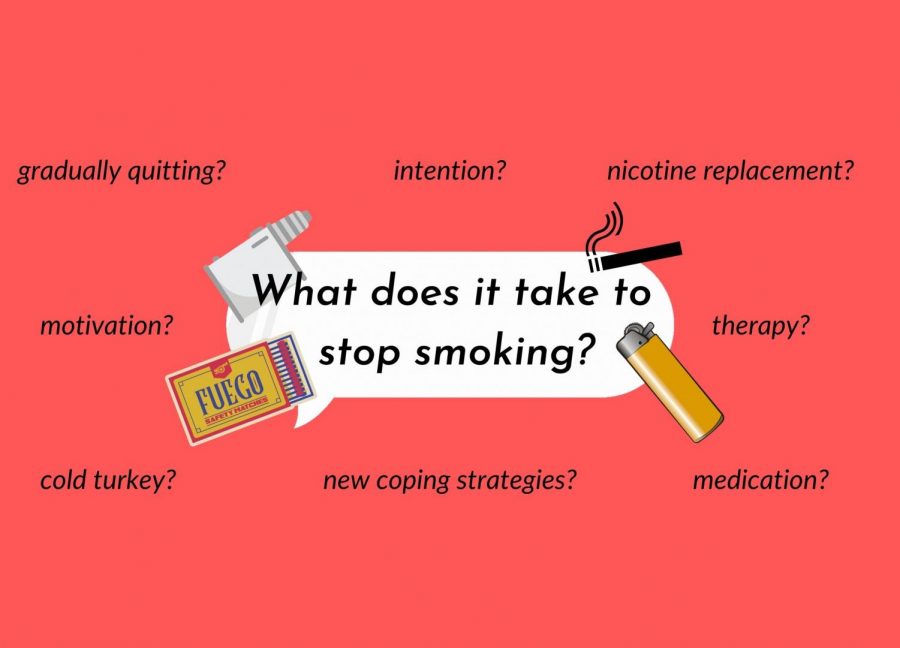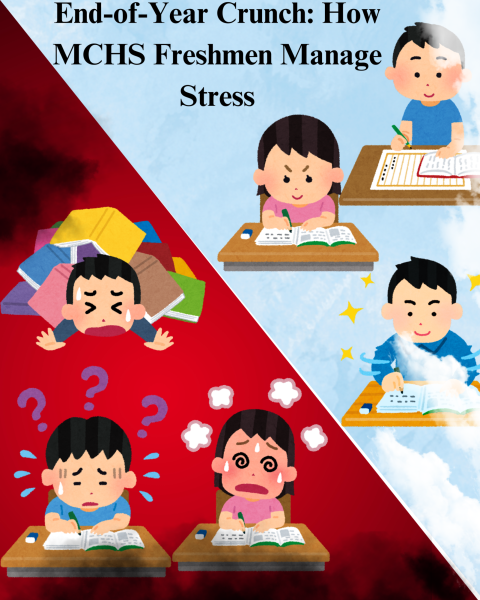What does it take to stop smoking?
Malena Fouts-Arteaga (Made with Canva)
When it comes to adolescent smoking, 26% of US high school students have been reported to be using any tobacco products in the past month.
Cancer, heart disease, stroke, lung diseases, diabetes, coronary heart disease, and delayed brain development. To some, it’s clear what all these mean, but it’s a given that none of us want any of these. For those who haven’t figured it out yet, these are just some of the health risks that come with smoking and vaping. With the rise of stress, anxiety, and depression, many are looking to smoking as a coping strategy, especially vaping. However, it’s important that we find coping mechanisms that aren’t harmful, which means finding the strength to quit and overcome addiction.
Before we get into actually quitting, there is some information that we need to know. Long-term addiction to smoking and vaping causes health problems, but so does constantly inhaling secondhand smoke. Secondhand smoke takes the lives of 41,000 adults and about 400 infants every year. It’s also known that living in a household with secondhand smoke can cause the same infections and diseases as actually smoking. Infants and children are at even more risk as they have weaker immunity. Sudden infant death syndrome, respiratory infections, ear diseases, slowed lung development, and worsened asthma for children who already have asthma are some of the possible effects of living in secondhand smoke. Not only are you putting yourself in danger, you’re putting the health of your loved ones at risk as well.
Smoking and vaping can weaken our lungs and heart, the most vital organs in the body. COVID-19 is a disease that affects the upper and lower respiratory tracts. When you combine the two, the outcome can be very ugly. It is reported that current smokers are 80% more likely to be hospitalized and even more likely to pass away due to the disease. If a smoker caught COVID-19 and managed to survive it, not only would they have to deal with the effects of smoking, but the effects that come with COVID-19 as well. When people recover from COVID, they are left with long-lasting symptoms such as fatigue, joint pain, chest pain, sleep complications, and loss of smell or taste, or having food taste sour, bitter, spoiled, or metallic.
When it comes to vaping there isn’t much research done on the long-lasting effects, whereas there is a lot of research done on smoking. However, there is a good amount of known short-term to medium-term effects that come from vaping. Just like smoking, there are some symptoms that come directly after vaping such as coughing and sore throat. When one vapes, the smoke or vapor that is released isn’t like water vapor, it’s an aerosol. This means that instead of evaporating and leaving the body, the aerosol vapor stays in the lungs, coating them. When this happens the lungs deteriorate and start to break down.
Addiction can be a difficult subject for some, and with good reason. Some have grown a dependency, feeling as if their body needs nicotine to live. And not only that but coping with withdrawals can be stressful. If there’s anyone you know that is actively trying to recover from addiction, it’s important to let them know that they have your support. Just knowing that someone is there for you while trying to overcome addiction can make it that much easier.
No matter what someone is trying to quit, having an intention and having the motivation to quit is the most crucial aspect in order to be successful. The very first step for quitting vaping is knowing why you want to quit. Will it be to improve your health? Is it too expensive? Has it been interfering with your friends or family? These are just examples and it’s up to you to find your real reason. Giving yourself time to develop the necessary confidence to quit is important. You can’t put it off for too long or else you’ll lose interest in wanting to quit.
Knowing what to expect, like withdrawals and temptations are also just as important. Nicotine withdrawals can be both psychological and physical. Symptoms can include a strong craving for nicotine, mood swings, frustration, low mood, and anxiety. Headaches, sweating, digestive issues, and difficulty with sleeping are also common. Typically these symptoms start after nicotine has been out of one’s body for 1-3 days. This can last up to 4 weeks. Preparing yourself for these symptoms can help, that way these symptoms won’t come as a surprise to you or cause you too much stress. The severeness of your addiction can also determine how bad your symptoms may be. Although it may seem like all withdrawal symptoms are bad, some of them can also be positive like improved airflow, sense of smell, and sense of taste.
Nicotine replacement therapy, also known as NRT, can help with cravings. NRT is when someone stops using tobacco or nicotine and uses one or more of the following: chewing gum, tablets, spray (mouth or nasal), and skin patches, which have lower levels of nicotine.
There are several different methods for quitting, but the most popular one that seems to have the biggest impact is “cold turkey.” Cold turkey is when one stops smoking or vaping entirely. They don’t lower their intake; instead, they just drop it altogether. In 2019, evidence from three randomized controlled trials proved that quitting cold turkey style had a better success rate than those who cut back their vaping. It is up to the person with the addiction to choose their method. Quitting gradually may be better for some and that is completely valid. The method really depends on the person.
Knowing your triggers can make your recovery easier. Things like stress, loneliness, withdrawal symptoms, and seeing others vape may trigger you to want to go back to vaping. Finding a new activity or hobby can keep away your boredom and loneliness. Talking to someone like a family member, friend, therapist, can help with stress and anxiety, which are two common triggers.
The road to recovery may be long, but it’s all worth it in the end. Know that people are there for you, all it takes is a little bit of reaching out. Recovery isn’t easy, so it’s up to you to decide how it’s going to end up. You only have one life to live, so don’t let something little become a big problem for you.

I love buying clothes for my dog, my favorite band is Lamp, and my favorite animal is the whale shark.





































